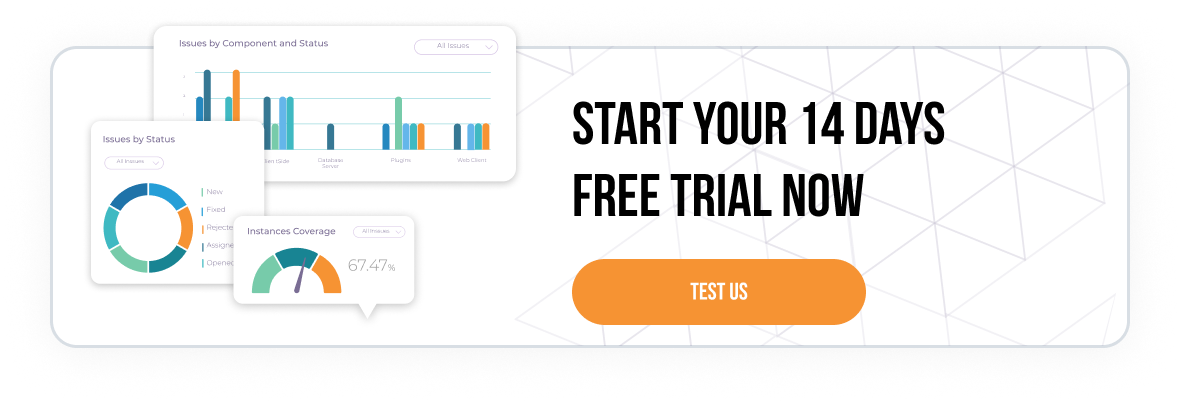How to Create an Effective Enterprise Testing Strategy
In This article
National banks. Retail giants. Multinational insurance providers. Global technology businesses. These enterprise companies typically have millions of customers around the world. Whether their users are sending money across an ocean, making billions of dollars in purchases, or streaming videos at lightning speed, the software that powers enterprise applications are complex, often subject to regulatory scrutiny, and require consistent maintenance.
The more complex the software, the greater the need for more sophisticated, robust enterprise testing solutions.

What is Enterprise Testing?
Enterprise testing is the process of assessing the software applications of large organizations to ensure high quality and optimal performance for end-users. It analyzes how the software performs in real-world scenarios to make certain that the user experience is smooth and that it functions as intended.
Similar to small and mid-sized businesses, enterprise companies are also faced with the challenge of ensuring software quality, reliability, and performance. However, at the enterprise level, scalability is absolutely paramount. That’s because these organizations are often focused on rapid growth, cost-effectiveness, and maintaining competitive advantage, all of which require scalable solutions.
The Key Components of an Effective Enterprise Testing Strategy
Enterprise application testing is about much more than simply identifying bugs. It’s about creating a comprehensive process to ensure that any software released to end-users is as flawless as possible. It’s about delivering a reliable product, building trust and brand loyalty, meeting demand for digital services, and being at the forefront of innovation.
Here are the top four elements of an enterprise testing process:
#1 Testing early
At the enterprise level, software defects can be especially harmful. Imagine a bug that goes unnoticed in a banking application during the account verification process. At this stage, a consumer has already entered their personal information, such as an ID number, credit card details, or other sensitive information. If a vulnerability is discovered, personal information may be compromised, opening the door to cyber threats. The repercussions of such an attack can include compliance penalties, network security upgrades, public distrust, and even legal action.
Testing during the early stages of development is absolutely essential. This significantly reduces the chance of bugs escaping into production, so that they can be addressed quickly and efficiently. Waiting until later increases the chance of higher costs to fix the bugs and can delay the software’s release.
#2 Employing automation
What exactly is automation in software testing? Automation in testing is the use of scripts or third party tools to automatically execute tests and confirm functionality, but with limited human involvement. A human tester writes the automation script, which then runs with the click of a button. Various automation tools can also be used, which typically integrate with a company’s internal systems, to automatically run tests.
Automation testing can significantly decrease the amount of time spent executing tests. This frees up time so that testers can focus on more important tasks. Unlike manual tests, which may be prone to human error and vulnerabilities, automation tests are far more accurate. The likelihood of overlooked steps are minimized, increasing the software’s reliability. Automation can accelerate the testing cycle and help companies release faster.
#3 Continuous testing
Is testing really ever completed? The answer is no. Companies often need to update their systems, change processes, adapt to consumer demand, and meet new compliance requirements.
At the enterprise level, even minor code changes can have a significant impact - positive or negative - on security, user experience, or performance. Considering how many interconnected systems exist for enterprise applications, small changes may accidentally introduce new bugs or cause an unexpected result with third-party software.
This necessitates a modern approach to testing such as CI/CD (continuous integration and continuous delivery). Applying CI/CD principles ensures that changes are thoroughly tested before release, reducing the likelihood of defects escaping into production. Organizations can then address small issues before they develop into large ones, saving time and costs.
#4 Adopting AI tools
AI has been one of the biggest buzzwords of the year, and for good reason. The ability to transform time-consuming, labor-intensive tasks into faster, automated, and more efficient processes shows considerable value. AI-powered testing capabilities help QA teams maximize efficiency and accelerate project delivery.
Faced with rapidly changing consumer trends, rising competition, and regulatory pressures, enterprises must adapt quickly. As an example, during the Covid pandemic, digital health services grew exponentially. According to McKinsey, “overall telehealth utilization for office visits and outpatient care was 78 times higher in April 2020 than in February 2020”.
Suddenly, healthcare companies found themselves with a surge of demand for doctor-patient video calls, remote patient monitoring, virtual therapy, online prescription refills, and more. With sophisticated AI testing features, healthcare companies could meet demand for digital services faster, and deliver high performing, reliable software applications.
Today, whether an enterprise develops mobile health apps, CRM systems, ERP systems, project management tools, or video editing applications, delivering high quality software quickly is the common thread. AI testing tools can enhance quality assurance and help make this a reality. In fact, according to the 2024 State of Testing™ Report, 40% of survey respondents claim to already be using AI tools for testing, and that number is likely to increase over time.
Methodologies for Enterprise Testing
Large organizations often deploy complex software applications. This requires implementing certain methodologies for ensuring functionality, high quality, and smooth user experiences. Let’s go over the common methodologies needed for efficient enterprise testing.
Agile
Perhaps the most popular testing methodology, agile is all about collaboration. In an agile environment, testers and developers work together, focusing on identifying and fixing bugs early in the development cycle. This supports a more flexible approach than traditional environments, when testing only began after development concluded. Agile teams conduct ongoing testing throughout software development, allowing them to adjust to code changes and bug fixes more efficiently. Enterprises who adopt agile methodologies will be better prepared to accelerate their software testing efforts and deploy products faster.
DevOps
The DevOps methodology encourages collaboration between software development (Dev) and IT operations (Ops). Similar to agile development, DevOps supports ongoing testing and delivery so that software can be created and released faster, but without sacrificing quality. This approach breaks down silos between these two departments to enhance communication and shared responsibility, often employing automation to accelerate project timelines. At the enterprise level, speed and efficiency are king.
Risk-based testing
How can enterprises reduce the likelihood of harmful defects and their impact on software delivery? The answer is by adopting a risk-based approach to enterprise testing.
Risk-based testing is a methodology that identifies low or high risk areas of the software being tested. QA teams can then prioritize their testing efforts accordingly. Testers focus on the most important areas of the software application first, so they can ensure smooth performance and high functionality. Advanced features like PractiTest’s Test Value Score help testers prioritize, identify tests for improvement, and retire low-value tests so they can focus on what matters most. The result is improved efficiency, time savings, and minimized risks.
BDD
BDD, short for Behavior-Driven Development, is a testing methodology that focuses on how a software application “behaves” in real-world scenarios based on the actions a real user would take. BDD tests are written in simple descriptions that even non-technical users can understand and follow. This approach provides QA teams with greater clarity, supports increased collaboration, and can minimize the amount of rework needed. Ultimately, BDD can improve the user experience and deliver a better product.
Building a Comprehensive Enterprise Testing Strategy
In order to ensure that their software applications, digital products, and services are reliable and secure, enterprises should build a comprehensive testing strategy. Today’s rapidly changing technological landscape - with consumer demand in the driver’s seat - is putting pressure on large organizations to deliver robust software fast.
It’s essential for enterprises to create a well-planned testing strategy. This should include critical thinking skills and specific points like:
-
Understanding business objectives and setting clear goals for each one
-
Identifying potential issues or defects during the early stages of development
-
Allocating resources to the most critical areas of testing
-
Implementing different methodologies based on software complexity and user needs
-
Employing continuous testing throughout the development lifecycle
-
Fostering collaboration and open communication for all stakeholders
Involving multiple stakeholders is essential. Encourage QA managers, developers, product managers, and even business users to add their points of view and feedback. Each has his or her unique perspective, which can add value to the overall software project. A checklist of software testing best practices can help organizations ensure they’ve considered important points.
How to Measure the Enterprise Testing Strategy
Simply creating a well-defined enterprise software testing plan is not enough. An equal focus must be kept on implementing, monitoring, and analyzing the same. The measurement of a successful enterprise testing strategy is made up of various development measurements to ensure that goals are met and areas for solutions are identified. This is where KPIs and QA metrics come into the picture, which include defect density, test coverage, and test effectiveness.
As discussed in the previous section, we can follow Agile and DevOps methodologies to increase efficiency and release faster. A big factor can be attributed to automation. Including automation testing metrics like automation test coverage as part of the measurement process will help us understand its contribution better. Also, when doing risk-based testing, it is important to verify that the areas we flagged as “high risk” and prioritize are needed as a metric. After all, if for some reason, we flagged certain areas as “high risk” but didn’t find any severe defects, it means we have to improve our risk analysis.
These metrics, when reviewed regularly allow teams to evaluate the effectiveness of their enterprise testing strategy. Having team meetings and including feedback loops is a good step to conclude the measurement process and improve further. This ensures that the strategy is not static but adapts to changes in development practices and business needs.
Test Management for Enterprises
A robust testing strategy can be even more effective with the right enterprise test management solution. An end-to-end test management platform like PractiTest combines all testing activities onto a single centralized hub. It includes real-time reporting and AI-powered capabilities to transform manual work into an automated process that takes much of the guesswork out of testing.
With an advanced test management platform, enterprises can identify bottlenecks and track important QA metrics. They can easily slice and dice their testing data and use those insights to apply data-driven decision making.
Even with powerful solutions like PractiTest available today, many enterprises continue to rely on legacy tools. These systems may have been innovative when they were first introduced, but in today’s fast-paced business environment, legacy systems are inefficient, prone to error, and expensive to maintain. Releasing high quality software simply can’t be done effectively with legacy tools.
To deliver high quality software and meet changing consumer demand, enterprise business leaders need an agile-ready solution. By identifying the key areas of their software applications and implementing a well-planned strategy and using an advanced test management solution, large organizations can confidently develop and release the high quality software their end-users expect.
























